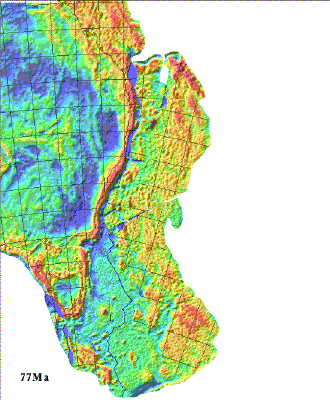The opening of the Tasman Sea:
A computer animation based on a new plate model used to rotate
present-day free-air gravity anomalies through time.

Background
The importance of intraplate stresses for the subsidence of sedimentary
basins has been recognized only recently. One of the main paradigms of
plate tectonics was thought to be that there is a limited number of large
tectonic plates that behave rigidly through long geological time intervals.
Instead recent analyses of intra-plate earthquakes and well-breakouts have
shown clearly that forces applied at plate boundaries, such as ridge push
and slab pull, propagate into large plates, and produce significant intra-plate
stresses. The relation between present day intra-plate stresses and plate
driving forces for the Indo-Australian plate has been investigated by measuring
in-situ stresses, and by calculating in-plane stresses based on models
of plate-driving forces. However, the Indo-Australian plate exhibits a
much more complicated stress pattern than most other major plates. Reconstructing
past plate motions provides our only key to model the major forces that
have driven plates in the past, resulted in differing intraplate stresses
through time, and affected basin subsidence and uplift.
Participants
R. Dietmar Müller, Geology and Geophysics, University of Sydney
Steven Cande, Scripps Inst. of Oceanography, San Diego, CA, USA
Joan Stock, California Institute of Technology
Walter R. Roest, Geological Survey of Canada, Geophysics Division, Ottawa,
Canada
Jean-Yves Royer, Lab. de Géodynamique, Villefranche sur Mar, France
Phil Symonds, Australian Geological Survey Organization
Ph.D. students:
Carmen Gaina, Geology and Geophysics, University of Sydney
Project aims
1) Create a self-consistent set of magnetic anomaly interpretations,
in the Indian and central/North Atlantic oceans.
2) Compute of a set of plate reconstructions including uncertainty estimates
for at least 15 time steps between chron 34 (83 Ma) and the present for
Australia-India, and Australia-Antarctica, North America-Greenland-Eurasia,
North America-Africa, and Antarctica-Africa-India, and Australia-Eurasia.
3) Determine of the timing of tectonic events within the resolution of
our plate model as compared with tectonic events recorded in basins on
Australia's passive margins.
The opening of the Tasman Sea:
A computer animation based on a new plate model used to rotate
present-day free-air gravity anomalies through time.
